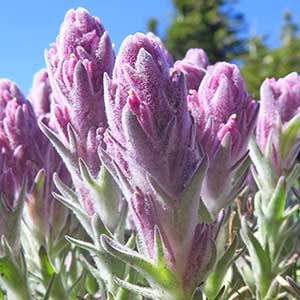Castilleja chromosa
Castilleja schizotricha
desert paintbrush
split hair Indian paintbrush, split-hair paintbrush
several to many, ascending to erect, often grayish, unbranched, rarely branched, sometimes with short, leafy axillary branches, hairs spreading-erect, long, stiff, eglandular, sometimes also with shorter, stipitate-glandular ones.
few to many, ascending to erect, unbranched, hairs dense, appressed-ascending, matted, long, soft, branched, eglandular, ± white-woolly, obscuring surface.
gray-green, linear, lanceolate, or oblanceolate, sometimes broadly lanceolate, (1.5–)2.5–6(–7) cm, not fleshy, margins plane, involute, (0–)3–5(–7)-lobed, sometimes with secondary lobes, apex acuminate to obtuse;
lobes spreading, linear, apex acuminate.
gray-green with hairs, surface green to purple, linear-lanceolate, 0.5–2 cm, not fleshy, margins plane, ± involute, 0(–3)-lobed, apex acute to acuminate, sometimes rounded;
lobes sometimes divergent, spreading-ascending, narrowly linear, apex acute.
2.5–15 (much longer in fruit) × 1.5–5.5 cm;
bracts proximally greenish to dull purplish, distally bright red to scarlet or orange-red, rarely yellowish to dull orange or pink, narrowly to broadly linear or lanceolate, narrowly ovate, or oblong-lanceolate, (0–)3–7-lobed, rarely with secondary lobes;
lobes spreading, linear to oblong, sometimes oblanceolate, often expanded near tip, long, proximal lobes arising below mid length, apex rounded or obtuse to sometimes acute.
3–8 × 1–2 cm;
bracts purple, lavender, pinkish, or dusty red throughout, sometimes greenish throughout or proximally greenish, distally colored as above, obscured by hairs, lanceolate, 3(–5)-lobed;
lobes ascending to erect, linear to oblanceolate, short, arising near or above mid length, apex obtuse.
straight or ± curved, 18–35(–40) mm;
tube 8–15 mm;
beak short- or long-exserted, adaxially green to yellow-green, (9–)10–18 mm;
abaxial lip deep green, reduced, thickened, included to exserted, 2–3 mm, ca. 20% as long as beak;
teeth incurved, deep green, 0.5–1 mm.
straight, 15–20 mm;
tube 8–9 mm;
beak included to slightly exserted, adaxially purple or pink, 3.9–5 mm, densely puberulent with white, woolly hairs;
abaxial lip deep purple, inconspicuous, pouched, pouches shallow, 3–5 mm, 80–100% as long as beak;
teeth upright-ascending, reduced, appearing white, 1.5–2 mm.
colored as bracts, sometimes with broad yellow band below colored lobe apices, (17–)20–27 mm;
abaxial clefts 4–10 mm, adaxial 6–12 mm, abaxial ca. 30% of calyx length, adaxial ca. 40% of calyx length, deeper than laterals, lateral 1–4 mm, ca. 15% of calyx length;
lobes oblong or ovate to narrowly triangular or lanceolate, apex obtuse to rounded.
colored as bracts, 11–18 mm;
abaxial and adaxial clefts 3.5–6 mm, 33–50% of calyx length, all 4 clefts subequal, lateral 4–6 mm, 33–50% of calyx length;
lobes linear, apex acute.
= 24, 48.
Castilleja chromosa
Castilleja schizotricha
Castilleja chromosa is sometimes confused with 3b. C. angustifolia var. dubia (see discussion there). Castilleja chromosa retains its distinctive morphology across its wide range and is a characteristic species of much of the southwestern United States. Where it overlaps with C. angustifolia, the two are distinguished by inflorescence color and width and by the lengths of the calyx, corolla, and corolla beak. In the broad region of their sympatry, there is little evidence of intergradation, except in a few sites in Elko County, Nevada, and in southern Wyoming. Throughout southern Idaho and northeastern Nevada the range of the two overlap with little or no intergradation. At high elevations in Montrose County, Colorado, C. chromosa has narrower leaves and a longer and silkier pubescence, especially in the inflorescence. Apparent hybrids between C. chromosa and C. flava var. rustica are known from Custer County, Idaho, and hybrids with C. linariifolia are known from Montrose County, Colorado.
(Discussion copyrighted by Flora of North America; reprinted with permission.)
Castilleja schizotricha is a rare species restricted to high elevations in the mountains in Siskiyou and Trinity counties in northwestern California and in Jackson and western Klamath counties in southwestern Oregon. See the discussion of 6. C. arachnoidea for morphological differences between it and C. schizotricha, as the two are sometimes confused. Though their ranges overlap, they do not appear to hybridize.
(Discussion copyrighted by Flora of North America; reprinted with permission.)


